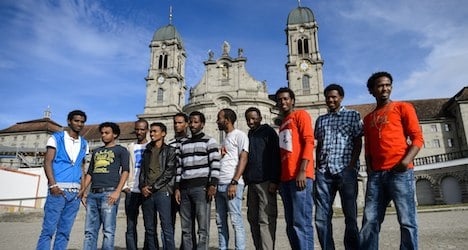The 21-year-old fingers his large crucifix as he walks past grazing cows and immaculately groomed horses towards the towering Einsiedeln Abbey.
"I'm very happy that I'm in this place. It is peaceful and there are no disturbances," said Teklestion above the sound of tolling church bells.
He is one of some 30 Eritrean asylum seekers given refuge this month at Switzerland's most famous monastery in the country's north, about 32 kilometres from Zurich.
Founded in 934 and, according to legend, miraculously consecrated by Christ himself, the Benedictine monastery's Black Madonna is said to have a magical aura.
It draws more than a million pilgrims a year to the tiny, idyllic town of Einsiedeln.
But since early October, the monastery has transformed a building that usually accommodates pilgrims into a makeshift asylum centre, with around 80 Eritreans expected to pass through by the end of the year.
"I'm Benedictine, everybody who knocks at the door of a monastery has a right to be heard," said Abbot Urban Federer, smiling behind steel-rimmed glasses, his broad gold and blue ring of rank hidden in the folds of his habit.
Influx of asylum seekers
And the central canton of Schwyz knocked.
"Like every other country in Europe, we have experienced a mass influx of asylum seekers, most of them Eritreans, since July," explained Fiona Elze of the Schwyz migration authorities.
"Our reception centres were full," she told AFP, and the monastery showed "exceptional readiness to help".
Between July and September, Switzerland received more than 7,800 asylum requests — a 45-percent jump from the same period a year earlier — with 3,500 of them having fled autocratic Eritrea.
The wealthy Alpine nation is bracing for a total of around 25,000 asylum applications this year, up from nearly 21,500 in 2013.
The growing numbers are distributed across Switzerland's 26 cantons, and Schwyz, with some 150,000 inhabitants, is required to take two percent, or around 500 people, Elze said.
"For a small canton, that is a demanding challenge," she said.
Many Swiss cantons are dealing with the influx by opening up some of the country's multitude of underground military shelters to house asylum seekers.
Schwyz also had that option, Elze said, but was wary of placing people in shelters without natural light.
"This is more humane," she said, nodding around one of two bright, tidy, bunk-lined rooms that together can hold 32 men at a time.
As they are transferred into more long-term housing in the community, new asylum seekers will take their place, but all are expected to be out by the end of the year.
There is also a schoolroom where the men take daily German lessons, a saw mill where some of them work to make pocket money, and a kitchen for most meals.
A hot lunch is provided each day in a dining area near the heart of the abbey.
The monastery's ornate Benedictine church with its peaceful gardens and stables set against the backdrop of rolling emerald hills alive with the chimes of cow bells definitely makes for a pleasant setting.
Most of the Eritreans here are, coincidentally, devout Christians, albeit Orthodox rather than Catholic, and many say they find solace in the spiritual settings and the tranquility of the church and the Madonna shrine — notably after difficult journeys to Europe.
Harrowing journeys
Several describe hiking across the Sahara desert through Sudan and into Libya, both assisted and abused by people smugglers.
And most, then, risked their lives crossing the Mediterranean.
"When we were picked up in the desert by the Libyan people smugglers, one tortured me badly," said Teklestion, speaking through a translator.
"I almost died."
Samuel Tesfmicher, 23, told AFP he was held in handcuffs for three months in Libya before being crammed into a boat that almost sank after days on the Mediterranean.
"Water gushed in," he said, saying he feels lucky not to be among the more than 3,000 migrants who have perished trying to cross that sea this year alone.
Father Urban said he was moved by the plight of these men and was happy he could do his "spiritual duty".
While many in Einsiedeln have embraced the project, others in the town of 15,000 inhabitants are horrified, he acknowledged.
Switzerland is among the countries in Europe that, per capita, take in most asylum seekers and resentment towards the newcomers is widespread, especially in conservative, traditional cantons like Schwyz.
"I have explained to them that they are not really welcome, and this is a fact," Elze said.
"It's simply honesty," she said, adding though that "now that they are here we will do our best."
Teklestion did not appear fazed, voicing hope he could get a work permit and become a productive member of Swiss society.
"I would like to get a job," he said, "and then I would like to establish a family, to have a good life."



 Please whitelist us to continue reading.
Please whitelist us to continue reading.
Member comments